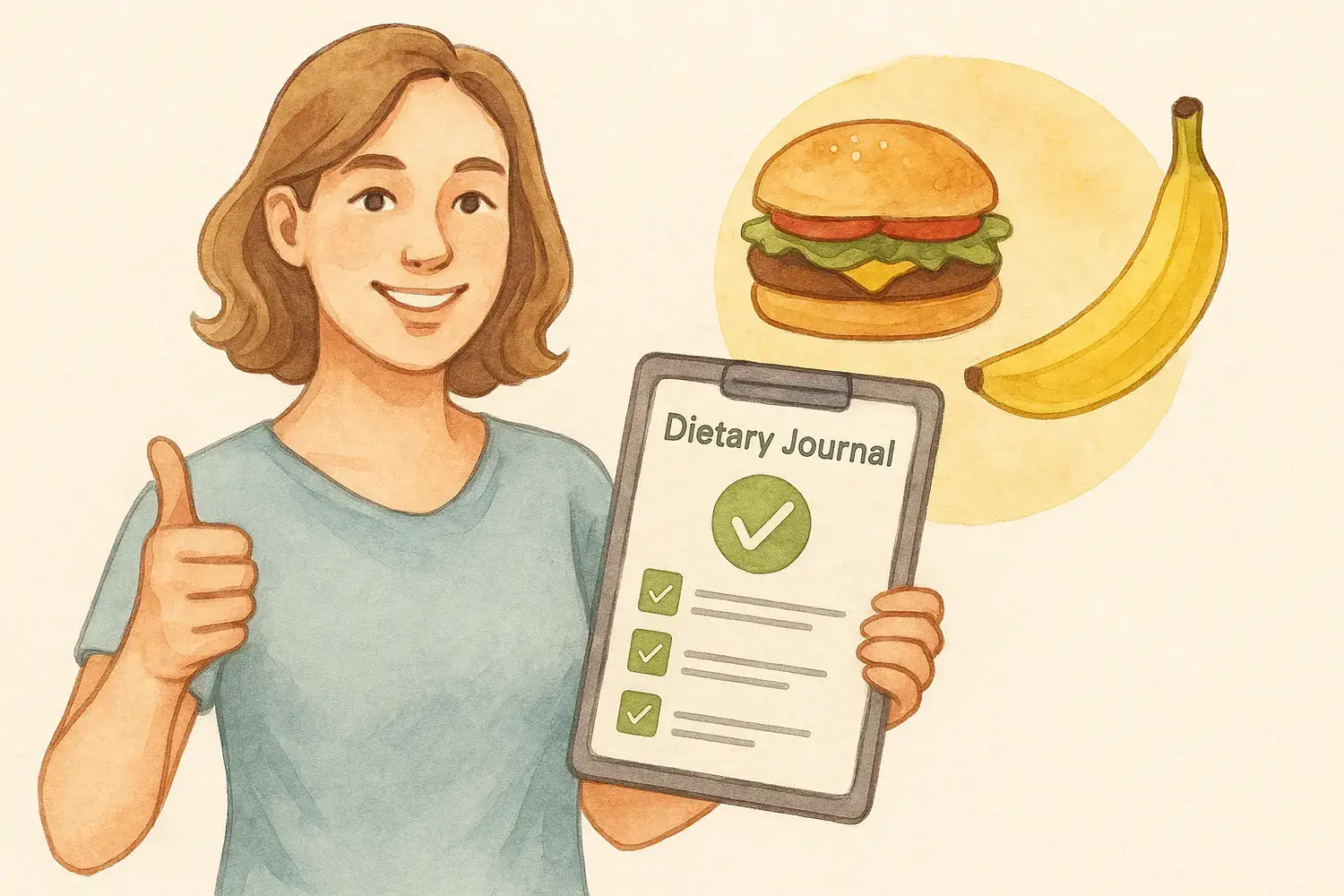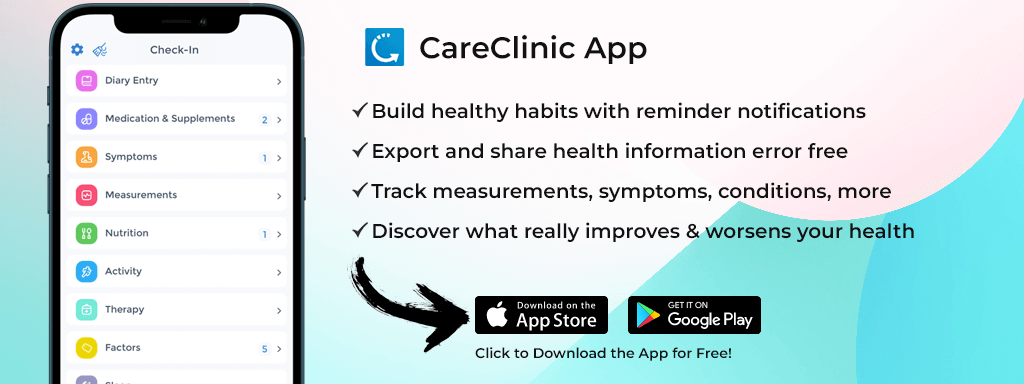
Food intolerance tracking requires systematic documentation of meals and symptoms to identify problematic foods. The process becomes manageable when structured methods are employed through dedicated tracking tools.
📋 Quick Takeaways
- Foods and symptoms tracked within 72 hours
- Reactions are documented across all body systems
- Healthcare reports are generated automatically
Table of Contents
- Step 1: Setting Up Your Food Diary
- Step 2: Recording Meals and Ingredients
- Step 3: Documenting Physical Reactions
- Step 4: Tracking Symptom Timing
- Step 5: Identifying Pattern Correlations
- Step 6: Managing Elimination Diets
- Step 7: Generating Healthcare Reports
- When Should a Food Intolerance Tracker Be Used?
- Common Mistakes Made While Logging Food Reactions
- What Makes CareClinic Different for Food Tracking
- Frequently Asked Questions
- Troubleshooting Common Issues
- Real-Life Tracking Scenarios
- Next Steps for Food Intolerance Management
Step 1: Setting Up Your Food Diary
The food diary setup is initiated by accessing the Nutrition section within CareClinic’s main dashboard.
The initial configuration of the food diary should be customized for specific intolerance concerns. Whether gluten or dairy is suspected as problematic, all details can be tracked comprehensively. Food components, portion sizes, and preparation methods are documented through the app’s interface. These details are considered essential when patterns between foods and symptoms need to be identified.
A baseline period of one week should be established before any foods are eliminated. Normal eating patterns are tracked during this time to provide reference data. Patterns become more apparent when this baseline data can be compared against elimination phases. The app’s preloaded food database ensures that common ingredients can be selected quickly without extensive typing.
For structured tracking protocols, the symptom tracking template should be reviewed for documentation guidelines.
Step 2: Recording Meals and Ingredients
Meal documentation is accomplished by tapping the ‘+’ icon and selecting Nutrition from the available options.
Successful food tracking is achieved through thorough documentation of every component. Rather than generic entries like “salad,” each ingredient should be listed separately – lettuce, tomatoes, cheese, dressing, and croutons. Any ingredient could potentially be identified as a trigger through this detailed approach. Meals should be logged immediately after consumption while details remain fresh. Important details are often forgotten when logging is delayed until day’s end.
Restaurant meals are documented differently since complete ingredient lists aren’t always known. The notes section should be utilized to record restaurant names and specific dishes ordered. Photos of meals can be attached to entries as visual reminders. These images prove valuable when symptom connections need to be established later.
Step 3: Documenting Physical Reactions
Physical reactions are recorded through the Symptoms tracker, which is accessed via the same ‘+’ icon interface.
Food intolerances are known to cause symptoms beyond digestive issues. Headaches, skin reactions, fatigue, and concentration difficulties are commonly reported. Multiple body systems can be affected, which is why comprehensive tracking capabilities are provided. Each symptom should be rated on a 1-10 severity scale. Progress can be monitored when these numerical ratings are tracked over time.
Mild symptoms should not be dismissed as unimportant. Slight bloating after meals might be the key to identifying problem foods. While some reactions occur immediately, others may be delayed up to 72 hours. Tracking should be continued even when immediate reactions aren’t noticed. This persistence often reveals delayed response patterns that would otherwise be missed.
For digestive-specific tracking methods, the digestive symptom tracker guide provides detailed protocols.
Step 4: Tracking Symptom Timing
Accurate timing is achieved by documenting exact consumption times and symptom onset periods.
Timing relationships between foods and symptoms are considered crucial for pattern identification. Some reactions are triggered within minutes while others may not manifest until the following day. The timeline visualization feature displays these temporal relationships clearly. Patterns that might be overlooked in standard logs become obvious when data is presented chronologically.
Symptom duration should be tracked alongside onset timing. A 30-minute headache presents different implications than one lasting all day. This duration data helps differentiate between minor sensitivities and significant intolerances. The severity and persistence of reactions guide decisions about which foods require complete elimination versus moderation.
Step 5: Identifying Pattern Correlations
Pattern identification is facilitated through the Insights section, where tracking data is analyzed comprehensively.

After several weeks of consistent tracking, connections between foods and symptoms are revealed. Patterns such as fatigue following bread consumption or bloating after dairy intake become apparent. The analysis features highlight how frequently symptoms appear after specific foods. Correlation strengths are displayed to help identify the most probable triggers.
Environmental factors, including stress, sleep quality, and medication,s are considered in the analysis. These variables often influence digestive function and immune responses. False positive identifications are prevented when multiple factors are analyzed together. This comprehensive approach ensures that dietary variety isn’t unnecessarily restricted based on coincidental associations.
Step 6: Managing Elimination Diets
Elimination diet protocols are structured through the Care Plan feature for systematic testing.
Once trigger foods have been identified, systematic testing through elimination is required. Single foods should be eliminated completely for 2-4 week periods. Progress tracking and reminder notifications are provided through the care plan system. Symptom improvements during elimination phases strongly suggest that triggers have been correctly identified.
The reintroduction phase is considered equally important for confirmation. Returning symptoms should be carefully monitored as they may present more intensely than before elimination. Symptom levels before, during, and after elimination are compared through the app’s features. This objective data supports informed decisions about permanent dietary modifications versus occasional consumption allowances.
For comprehensive digestive monitoring during elimination phases, the digestive health tracker provides additional support.
Step 7: Generating Healthcare Reports
Professional healthcare reports are generated through the Reports section accessible from the main menu.
Tracking data becomes valuable clinical documentation when compiled into professional reports. Food diaries, symptom logs, and correlation analyses are automatically formatted for healthcare providers. These comprehensive reports save consultation time while providing concrete data for medical decision-making. Multiple export formats, including PDF and CS,V are supported for provider preferences.
Report customization allows focus on specific timeframes or symptom categories. Visual charts and correlation graphs are included to enhance data interpretation. HIPAA-compliant security measures protect all exported data. Maximum file sizes of 25MB accommodate extensive tracking histories while maintaining email compatibility.
When Should a Food Intolerance Tracker Be Used?
Food intolerance tracking should be initiated when recurring symptoms appear after meals.
Symptoms such as bloating, headaches, or skin reactions that seem meal-related indicate tracking would be beneficial. The process proves especially valuable when specific trigger foods cannot be identified through observation alone. Systematic documentation reveals patterns that memory-based tracking often misses.
Common Mistakes Made While Logging Food Reactions
Insufficient detail in food documentation represents the most common tracking error.
Generic entries like “pasta” provide little value when the actual trigger might be tomato sauce or cheese. Tracking abandonment after one week prevents pattern identification since many intolerances require extended observation. Good days must be documented alongside symptomatic days to establish meaningful comparisons. Delayed reactions are frequently overlooked when tracking focuses only on immediate responses.
What Makes CareClinic Different for Food Tracking
Integration of multiple health metrics distinguishes CareClinic from basic food diaries.
Medications, stress levels, sleep quality, and exercise are tracked alongside food intake. This comprehensive data collection reveals complex interactions that single-purpose apps miss. Symptom patterns influenced by non-dietary factors become apparent through integrated analysis. Professional report generation transforms personal tracking into clinical documentation valued by healthcare providers.
Frequently Asked Questions
What information should be included in food diary entries?
All ingredients, cooking methods, portion sizes, and consumption times should be documented. Beverages, condiments, and cooking oils are included since any component could be problematic.
Can apps accurately identify food intolerances?
Pattern recognition is enhanced through systematic data organization, though medical diagnosis remains necessary. Apps provide documentation that supports clinical evaluation.
How long should foods be tracked before patterns emerge?
Minimum tracking periods of 4-6 weeks are recommended for reliable pattern identification. Delayed reactions require extended observation.
What distinguishes allergy tracking from intolerance tracking?
Immediate, dangerous reactions characterize allergies, while delayed discomfort indicates intolerances. Different tracking approaches are required.
Should mild symptoms be tracked?
All symptoms, regardless of severity, should be documented. Mild reactions often provide crucial pattern clues.
Troubleshooting Common Issues
Too many foods seem problematic
Common ingredients like gluten or lactose may be responsible when numerous foods trigger symptoms. Category testing should be implemented rather than individual food elimination.
No patterns emerge after weeks
Non-food triggers, including stress or environmental factors, should be considered. Tracking scope expansion often reveals overlooked causes.
Symptoms worsen during elimination
Nutritional deficiencies from excessive restriction may cause new symptoms. Professional guidance ensures adequate nutrition during elimination phases.
Before Tracking vs After 30 Days
| Before: | After 30 Days: |
| • Mystery symptoms persist • Random food avoidance • Ineffective restrictions • Vague provider descriptions |
• Clear triggers identified • Evidence-based choices • Targeted eliminations • Detailed clinical reports |
For IBS-specific protocols, the IBS tracking guide provides condition-specific strategies.
Quick Knowledge Check
Q1: How long should suspected triggers be tracked?
A: Minimum 4-6 weeks for reliable patterns
Q2: When do most food reactions occur?
A: Within 72 hours of consumption
Q3: What tracking combination proves most effective?
A: Foods + symptoms + timing + environmental factors
7-Day Tracking Challenge
• Days 1-2: Food diary setup and meal logging practice
• Days 3-4: Symptom tracking addition after meals
• Day 5: Initial pattern review in Insights
• Day 6: Weekly summary creation
• Day 7: Elimination planning based on findings
Real-Life Tracking Scenarios
Bloating occurring four hours post-lunch requires detailed documentation. When a salad containing cheese, walnuts, and ranch dressing is consumed at 12:30 PM, each component should be logged separately. The bloating onset at 4:30 PM is recorded with a 6/10 severity rating. After two weeks, patterns revealing dairy as the common factor in symptomatic meals become apparent. Dairy elimination can then be tested systematically.
Delayed skin reactions present different tracking challenges. A rash developing 48 hours after tomato consumption wouldn’t be connected without systematic tracking. When patterns show Monday’s pasta followed by Wednesday’s rash, and Friday’s pizza followed by Sunday’s rash, the tomato connection becomes evident. These delayed correlations are revealed only through consistent documentation.
Next Steps for Food Intolerance Management
Food trigger identification requires patience and systematic tracking over extended periods. The initial tedium of detailed documentation is offset by the relief of finally understanding symptom causes. Individual trigger patterns vary significantly, making personalized tracking essential.
CareClinic’s comprehensive health tracking platform makes this detective work manageable. Connections between foods, symptoms, timing, and environmental factors are revealed through integrated analysis. The journey toward better digestive health begins with consistent tracking implementation.
For Crohn’s-specific tracking strategies, the Crohn’s disease food diary provides specialized guidance.


